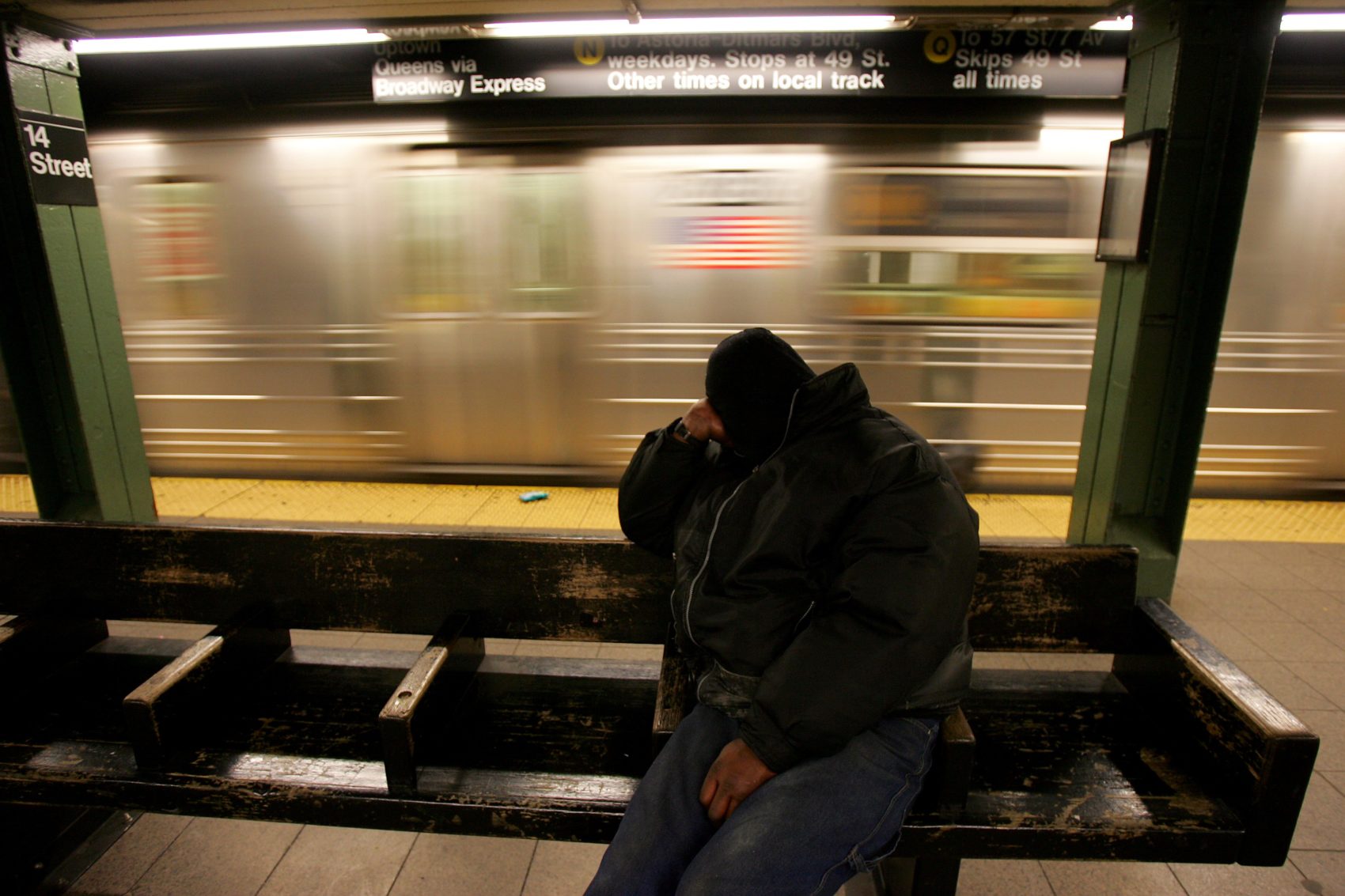New York City’s Homeless Diversion Program is ‘Smoke and Mirrors’ Reform, Advocates Say
A new effort to reduce arrests and summonses is criticized as continuing to criminalize homelessness.

This month, New York City Mayor Bill de Blasio’s office started a pilot initiative for homeless people arrested or given summonses by the NYPD in the subway. Currently, offenses like fare evasion, taking up two seats on the subway, and having your feet on a subway seat can result in a court summons and, sometimes, arrest. The program aims to connect people to shelter and services instead.
Under the new Subway Diversion Project, people without shelter who agree to participate will be connected to HOME-STAT, a homeless outreach program, and the summons from the NYPD encounter will be automatically cleared. Social workers and other staff of the city’s three-year-old program document homeless people living on the street and try to persuade them to accept shelter and other services.
District Attorney Cy Vance called the program “potentially life-altering.” “Our office is proud to continue investing in structural reforms that keep New Yorkers out of the justice system and provide more meaningful interventions instead,” Vance said in a press release announcing the program.
Advocates and organizers in the city say the program is not what it seems. Joshua Goldfein, a staff attorney with the Legal Aid Society’s Homeless Rights Project, said it’s a “smoke and mirrors” reform that fails to end the criminalization of homelessness in New York City.
If the goal is to help homeless people, “you try to earn somebody’s trust and offer them services that they need,” Goldfein said. “You don’t start off by giving them a summons and then say to them ‘but I’ll remove this threat hanging over your head if you come in and accept services.’ That’s coercive. No one’s going to do it.”
In response, the NYPD said in an email: “The NYPD works continuously with our partners—such as the MTA, the Manhattan District Attorney’s office, DHS, and the Bowery Residents’ Committee (BRC)—to connect those in need with critical services, and to improve quality of life and safety on the subways and across the city. These partnerships include innovative solutions like this one to strike a sensible balance and to deliver real results for New Yorkers.”
The mayor’s office and the Mayor’s Office of Criminal Justice did not respond to requests for comment, but in the press release, de Blasio trumpeted the plan’s potential. “Subjecting these individuals to criminal justice involvement for low level, nonviolent offenses is not the answer and does not help anyone,” he said. “This initiative strikes the right balance, and we are excited to give it a try as we expand approaches to prevent and address homelessness.”
Goldfein said the program’s approach doesn’t make sense. For one thing, the population living on the street is usually very “service-resistant,” he said, and often have dealt with trauma and may have mental health issues. “They’re on the street because they’ve already turned down the service that they’re most in need of, which is shelter,” he explained. “It’s difficult to build a relationship with them that will overcome that resistance.”
“You need to be all carrots. It’s not a population that you can effectively build a relationship with if you’re carrying around sticks.”
Picture The Homeless, a local organization of homeless people organizing for their rights, has criticized the city’s shelter system—the prime service offered in this diversion project as well as through HOME-STAT—as well as de Blasio’s plan to expand it. In 2018, Picture the Homeless released a “The Business of Homelessness,” a study that showed that shelters cost the city more than subsidizing housing. The group called the city’s shelters inadequate, “understaffed and unsafe.”
Though de Blasio’s announced an affordable-housing plan in 2014, some critics have said it could fuel gentrification and would actually leave out many of the people who need it most. Eligibility for the units is based on an area median income that includes all five boroughs as well as the wealthier Westchester and Putnam counties. In East New York, for example, 55 percent of people couldn’t afford even the “affordable” units in the plan, according to a 2015 study by Comptroller Scott Stringer.
Bob Gangi, executive director of the Police Reform Organizing Project, which monitors New York City courts, said the city hasn’t fully addressed the needs of homeless people—for either housing or services—but still funds the policing of so-called quality-of-life crimes.
“This program is a prime example of this misguided government practice of using cops or law enforcement to respond to a social problem or a government health problem that other departments should be responding to,” Gangi said.
He and other advocates have questioned why the NYPD should be interacting with vulnerable populations in the subway at all, particularly when the violations are as minor as lying down on a subway seat.
“We’re in the arraignment courts often and we see it regularly,” Gangi said. “Homeless people, mentally disoriented people who the cops have arrested for one fucked up reason or another and they’re locked up overnight and they come before the judge.”
“There’s a real cruelty to it, there’s a real brutality to it. It’s also been normalized—cops responding to people who are in distress.”
Editor’s note: This story has been updated with a response from the NYPD.
